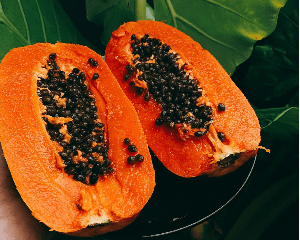 About Papaya
About Papaya
- Papaya - otherwise called pawpaw or papaw - is part of the Caricaceae botanical family.
- Papaya is thought to have originated in Mexico and Central America, but is now grown all over the world in subtropical regions.
- It can be found in grocery stores year-round in their ripe or unripe form.
- A ripe papaya has yellowish skin with orange flesh. These are typically used in sweet dishes such as smoothies, salsas and salads.
- Unripe papayas are green with a firm white flesh. These are typically cooked and used in savory dishes since they don't have the sweetness of a ripe papaya.
- Select one that is firm to the touch with smooth skin. A ripe papaya should slightly yield under the pressure of your finger. Avoid those that are overly soft or have blemishes.
Nutrition Information
- Papaya is an excellent source of vitamin C and vitamin A and a good source of folate, potassium and fiber.
- Vitamin C supports absorption of iron in the diet. Vitamin C is also involved in wound healing.
- Vitamin A plays a role in immune function, vision and reproduction. It's also essential in normal formation and maintenance of the heart, lungs, and kidneys.
- Folate is used to make DNA and is essential for women who may become, or are currently, pregnant to reduce the risk of neural tube defects.
- Potassium regulates fluid within the body and helps to maintain normal blood pressure.
- Fiber helps you to feel fuller faster, which can help with weight control. Eating fiber rich foods also supports a healthy digestive system.
- It contains the carotenoid lycopene in its flesh and lutein and beta-carotene in its peel. Carotenoids are antioxidants that may reduce your risk of disease including cancer and eye disease.
Storing and Preparing
- Store unripe papayas at room temperature for 2-3 days or until they are completely yellow to orange in color.
- Store in the refrigerator once ripe and eat within a day to two for the best flavor.
- To prepare, cut it in half lengthwise and remove the seeds. To remove the skin, use a vegetable peeler or paring knife. Cut papaya into wedges or dice into smaller pieces.
Nutrition Facts
1 cup diced papaya
Calories: 62 | Protein: 0.68 g | Fat: 0.37 g | Carbohydrate: 15.7 g | Fiber: 2.46 g | Calcium: 29 mg | Magnesium: 30.4 mg | Potassium: 264 mg | Folate: 53.6 µg | Vitamin A: 68.2 IU | Vitamin C: 88.3 mg |
Recipes
Request an Appointment